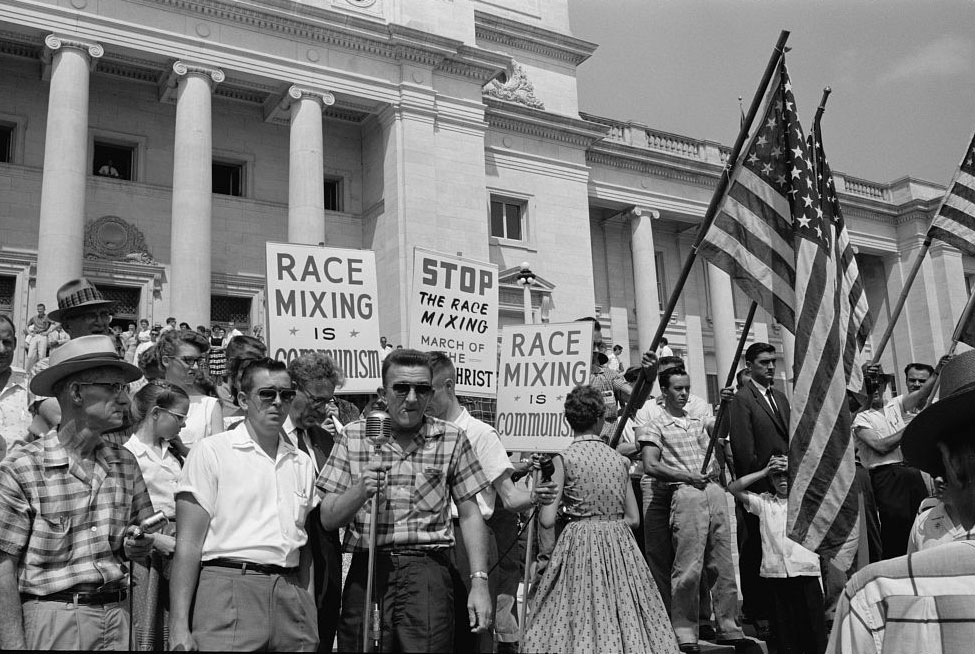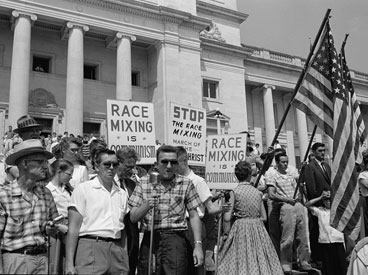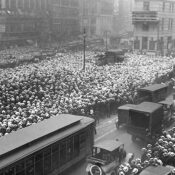This is the third installment in our six-part series, “The Long March on Washington.” In part one, “It’s Our Country, Too,” we looked at the limited wartime opportunities for black Americans in the 1940s. In part two, “Black Neighbors, White Neighborhoods,” we covered integration in neighborhoods throughout the 1950s.

Black Americans might have hoped that the Supreme Court’s 1954 ruling in Brown v. Board of Education signaled the end of segregated schooling. But they soon learned not to hope for so much. Many states delayed or simply ignored the court’s order for “prompt and reasonable” integration of black students into white schools.
State defiance of federal law erupted in a bitter confrontation in 1957, at Little Rock, Arkansas. Seeking to comply with the Supreme Court, Little Rock’s school board developed a plan to integrate its all-white Central High School.
Unfortunately, as the superintendent of Little Rock schools later wrote in the Post, the plans to integrate black students were violently derailed by a combination of “organized bigotry, economic pressures, and selfish political scheming.”
In the five-part series “The Untold Story of Little Rock” (May-June 1959), Superintendent Virgil T. Blossom told how Arkansas Gov. Orval Faubus withdrew his support for the integration plans after he felt pressure from the state’s segregationists. By the time the school year had begun in September of 1957, Faubus was obstructing any attempt to introduce black students to white schools, which only encouraged the racists’ hopes of turning back integration. They redoubled their efforts, demanding further concessions from the school board as well as threatening violence against its members and their families.
Into this volatile situation stepped nine black students who bravely volunteered to enroll at Central, knowing the hostile reception that awaited them.
When Faubus heard of their intention, he ordered the state’s National Guard to keep black students off the school’s property. On the morning of September 4, wrote Superintendant Blossom, the first of these students, Elizabeth Eckford, approached the school, walking directly up to the line of guardsmen who closed ranks to block her way. She turned around, walked down the block and approached the line of guardsmen once more. “Again the guardsmen lining the sidewalk pressed together to block her path and she swerved to walk steadily down the line of troops, seeking an opening to the school grounds. She found none.”
At this point, a group of about 200 white adults saw her. They ran to block her path, surrounding her and screaming abuse and threats. The police and guardsman simply looked on impassively. “Trembling, but never losing her dignity, the Negro girl made a third vain effort to walk through the line of soldiers,” Blossom wrote. Realizing she couldn’t enter the school, she walked to a bus stop and silently waited while the crowd followed her pouring out insults and threats. When the bus came, she climbed aboard.
The Guard continued to keep black students out of Central High while a noisy mob surrounded the school shouting their defiance of integration, breaking into choruses of “Dixie,” and waving rebel flags. Then, on September 24, President Dwight Eisenhower decided he’d seen enough defiance of federal authority. He ordered the Army’s 101st Airborne Division to the city to replace the National Guard.
Each day for the next eight months, paratroopers escorted black students as they approached and left the school. At times, they even accompanied them in the school halls between classes. They regularly conducted school-wide bomb searches twice a day, and they kept the protestors in the street from slipping into the building.
Before the month was over, all nine black students had been admitted to Central and were attending classes, though continually taunted, threatened, shoved, and spat upon by white classmates.
The confrontation at Little Rock was the big story in the fall of 1957, both nationally and internationally. Blossom wrote, “A young American mountain climber at Gilgit, in Northwest Kashmir, reported there was ‘news about the Little Rock trouble on virtually every page’ of the newspapers and people repeatedly asked him whether ‘the United States really practices democracy as it tells us.’ Photographs and newspaper stories appeared on the front pages in virtually every city in Europe.” The Communist papers played up the story as much as possible, Blossom continued.
In his articles, Blossom was honest enough to admit he, personally, didn’t like the idea of integration. Yet, as school superintendant, he was determined to enforce the Supreme Court’s order, despite the opposition of Faubus and the threats from racists.
The Army continued enforcing integration until the school year ended in May. Before the next school year could begin, Faubus secured his support from Arkansas’ segregationists by ordering all four high schools in Little Rock to be closed.
Concluding his series of articles, Blossom felt the blame for Little Rock’s troubles shouldn’t have been placed solely on the opponents of integration: the demagogues, white supremacists, Klansmen, racist students, and freelance thugs that swarmed around the school. He believed the federal government was also responsible for the problems because it had enforced integration with the military. He agreed with a southern congressman who told him, “when the President sent the Army’s toughest troops with bayonets on their guns against unarmed white citizens, he made a mistake we will never forgive.” Like many of his contemporaries, he believed integration would only be achieved peacefully, slowly, and reasonably.
The federal government, it appeared, had no overall plan for protecting its black citizens’ civil rights. Meanwhile, segregationists were organizing their efforts to stall integration
Coming Next: “The Deep South Says, ‘Never.’”
Become a Saturday Evening Post member and enjoy unlimited access. Subscribe now



